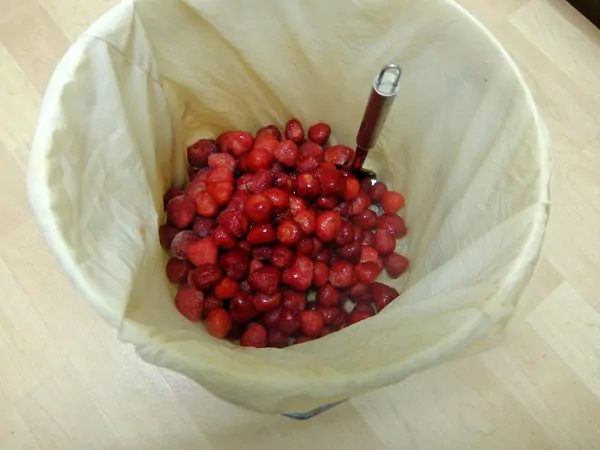What Is Melomel & How To Make It

Mead or Honey wine has the most archaic and names for the varies styles and sub-styles of any drink around. Melomel is among those names that don’t make much sense when you hear it and maybe that is why such a delicious drink doesn’t get the recognition it deserves.
Table of Contents
What Is Melomel?
Melomel is a fruit mead. That is a honey wine with a fruit flavouring whether that be strawberry, cherry or pear.
If you are interested in mead, melomel is where things get interesting. Honey is the base to which whatever fruit is being added can compliment or shine through. There is a huge variety of fruits as well as other flavourings such as spices can be added to produce, literally hundreds, of different types of melomel.
Mead, Melomel & Other Names
Melomel is the term for fruit mead but rather confusingly there are further names that cover particular types of fruit wine. This means an apple melomel might be called a “Cyser” or a grape melomel a “Pyment”.
These naming conventions muddy the waters somewhat but in essence they all refer to mead, melomel refers to fruit mead and then there are further names, which I shall list some of below;
- Cyser – Apple Mead
- Pyment – Grape Mead
- Rhodomel – Rosehip Mead
- Braggot – Barley Mead
- Rudamel – Raspberry Mead
How Are Melomels Made

If you have ever made mead before then you will be aware that it is quite straightforward. In fact, it is one of the simplest alcoholic beverage to make at home.
Adding fruit into the equation is still simple. There is an additional step and it is a case of determining when to add the fruit. There are several methods:
During Primary Fermentation: This method is most common and it is a case of adding the fruit with the honey at the very outset of fermentation when pitching the yeast.
Adding fruit during the most active part of fermentation is helpful to breakdown the fruit and extract a lot of juice and flavour. It is best for strongly flavoured fruits and firm-fleshed fruit.
During Secondary Fermentation: Another option is to add the fruit after the initial burst of fermentation activity has subsided. This is a better option when using more subtle or delicately flavoured fruit. The thinking is that the vigorous fermentation and production of CO2 scrubs delicate flavours out of the mead. There is also a degree of alcohol present that helps extract flavour and prevent wild yeast or bacteria from growing (although this is very unlikely).
Fruit Puree or Flavouring Prior to Bottling: The last option is to add fruit flavourings, extracts or purees after the fermentation activity has finished and prior to bottling the mead.
This is most appropriate when using extracts and essences as they are ready-made flavours that fermentation doesn’t affect. Adding the flavour just prior to bottling will ensure the flavour is the same when you open a bottle as when it was added.
How To Make Your Own Melomel

To make your own melomel I would first suggest to familiarise yourself with basic mead making. You can use this recipe as a base for a fruit mead or you can follow this guide to making an apple mead or cyser.
Below I will outline how to make a Berry Melomel which will be approx. 13-14% ABV , you can then substitute in any kind of berry you want:
Berry Melomel 13% ABV Ingredients – Make 4.5 Litres / 1 Gallon
- 1.3kg of Good Honey (preferably varietal or your favourite)
- 1kg Berries
- 4.2 litres Water (collect and leave overnight to dissipate chlorine)
- 1 Campden Tablet
- 1 tsp Yeast Nutrient
- 1/4 – 1/2 tsp Acid Blend to taste
- 1 tsp Pectic Enzyme
- 1 sachet of yeast (we recommend Lalvin D-47)
Berry Melomel Method
In a 2 gallon fermenting bucket add the berries to a fine-meshed straining bag and crush slightly with a potato masher. Secure the top of the bag to keep the berries contained.
Pour over the honey and enough water to make up to 4.5 litres or 1 gallon. Make sure the honey is mixed with the water thoroughly and add a crushed Campden tablet. Cover and leave overnight.
Add the acid blend, pectic enzyme and mix thoroughly. Pitch the yeast onto the surface of the must and then cover the fermenter and fit an airlock.
Allow to ferment for at least 7 days and then lift out the straining bag with the berries and allow to drip drain. Recover the fermenting vessel and leave for a further 24 hours.
Rack the Melomel to a demijohn and fit a bung and airlock. Allow to condition and clarify for at least 2 – 3 months, up to 6 months, racking to a clean demijohn when necessary (such as when sediment builds up in the bottom of the vessel)
Once completely clear transfer the Berry Melomel to bottles and cork. Wait a few months if you can be patient before sampling.




Starting with a 2 gallon bucket making 1 gallon of mead as above. When I remove the fruit and rack. Can I rack into a 2 gallon demijohn ? and do I have to fill the air space that is created because its only one gallon of liquid?
It is a good idea to leave as little airspace as possible when racking as there is a chance of oxidation occurring with more air contacting the surface of the mead.
Obviously, this isn’t always practical and I find if there is still some fermentation occurring the headspace will fill with carbon dioxide preventing oxidation for the most part. If there is still some active fermentation then I wouldn’t be too concerned about the extra headspace.
Wow, never knew that they have such high alcoholic content?! Mead is pretty popular these days, saw a couple of pubs adding them to their boards.